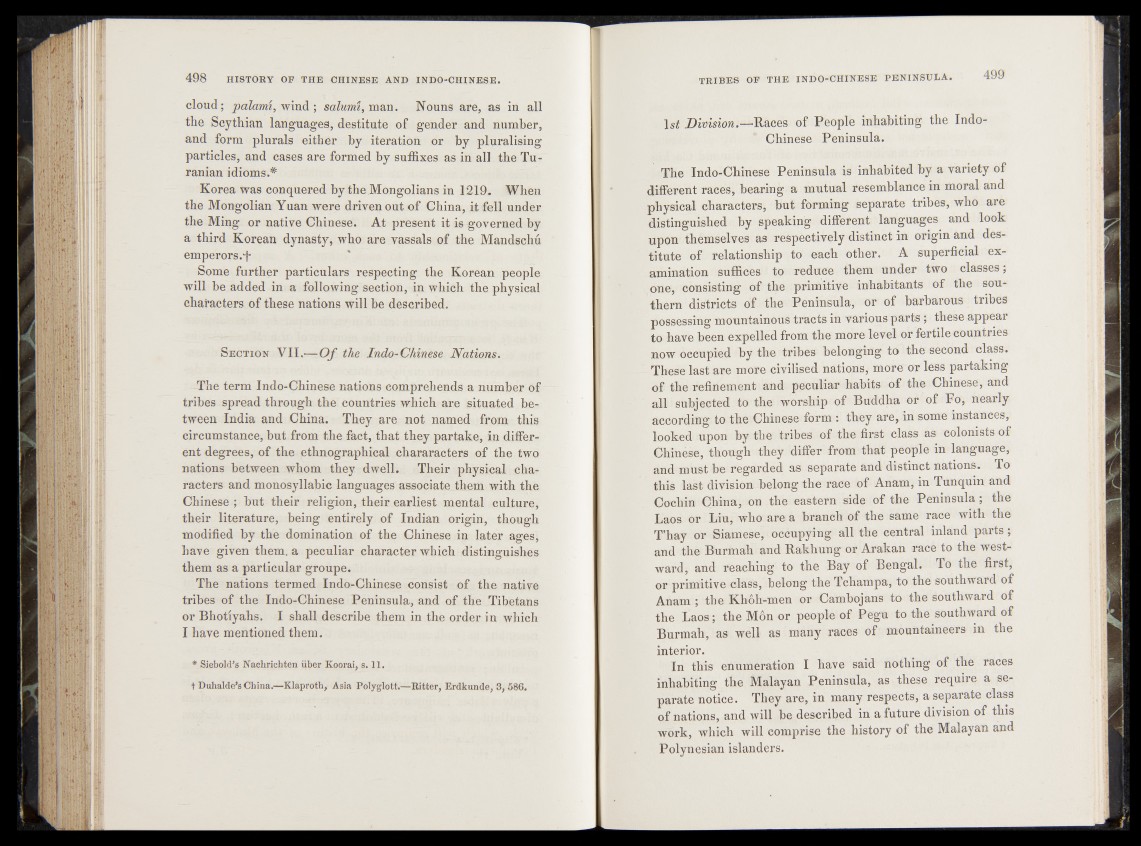
cloud; palami, wind; salumi, man. Nouns are, as in all
the Scythian languages, destitute of gender and number,
and form plurals either by iteration or by pluralising
particles, and cases are formed by suffixes as in all. the Turanian
idioms.*
Korea was conquered by the Mongolians in 1219, When
the Mongolian Yuan were driven out of China, it fell under
the Ming or native Chinese. At present it i# governed by
a third Korean dynasty, who are vassals of the Mandschu
emperors .*f*
Some further particulars respecting the Korean people
will be added in a following section, in which the physical
characters of these nations will be described.
S e c t io n VII.—Of the Indo-Chinese Nations.
-The term Indo-Chinese nations comprehends a number of
tribes spread through the countries which are situated be-?
tween India and China. They are not named from this
circumstance, but from the fact, that they partake, in diifefe;
ent degrees, of the ethnographical chararacters of the two
nations between whom they dwell. Their physical characters
and monosyllabic languages associate.tbem with the
Chinese ; but their religion, their earliest mental „culture,
their literature, being entirely of Indian origin, though
modified by the domination of the Chinese ip later ages;
have given them, a peculiar character which distinguishes
them as a particular groupe.
The nations termed Indo.-Chinese consist of the native
tribes of the Indo-Chinese Peninsula, and of the Tibetans
or Bhotiyahs. I shall describe them in the order in which
I have mentioned them.
* Siebold’s Nachrichten über Koorai, s. 11.
t Duhalde’sChina.—Klaproth, Aaia Polyglott.—Ritter, Erdkunde, 3,586.
1 s t D i v i s i o n of People inhabiting, the Indo-
Chinese’ Peninsula.
The Indo-Chinese Peninsula is- inhabited by a variety of
different races, bearing a mutual resemblance in moral and
physical characters, but forming .separate tribes, who are
distinguished by speaking different languages and look
upon' thèmselves as respectively distinct in origin ànd destitute
of relationship to each other. A superficial examination
suffices; to reduce them Under two classes ;
one, consisting of the ; primitive , inhabitants of the southern
districts of the Peninsula, orr of barbarous- tribes
possessing mountainoué tracts invalriouspUrts; - these appear
to have been expelled from the more level or fertile^ountries
now'Occupied by the tribes belonging to Hhè second class.
-These last are more civilised nations, mote or less partaking
of the refinement and peculiar habits'épi Ain and
all subjected to Ae’-worship* of Buddhaior of Fo, nearly
according to the^Chinese.form :• ïhêy are,-in some instances,*
looked-Upon by. the- tribes- oL-the first class as--colonists of
Chinés®, though they differ from that people Slanguage,
and must be regarded as .separate and distinct nations;? To
this last divisioni belong the race of Anam, in Tunquin and
Cochin Cffi‘ina,Aon the eastern side of the Peninsula; the
Laos or Liu, who are a branch of the -samerace - with the
T’hay or Siamese, loccupying all the central inland parts ;
and the Burïnah and Rakhung or Arakan -racé to the westward,
and reaching to the Bay of Bengal. To the first,
or primitive.class, belong the Tchampa, to the southward of
Anam; the Khôh-men or Camboj&Us to thesouthward of
the Laos; the Mon or people of Peg® to the southward of
Burmah, as well as many races of' mountaine##» in the
interior. .
In this enumeration I have said nothing bf the races
inhabiting the Malayan Peninsula, as these require a separate
notice. They are, in many respects, a separate class
of nations, and will beudescribed in a future division of this
work, which will comprise the history of the Malayan and
Polynesian islanders.